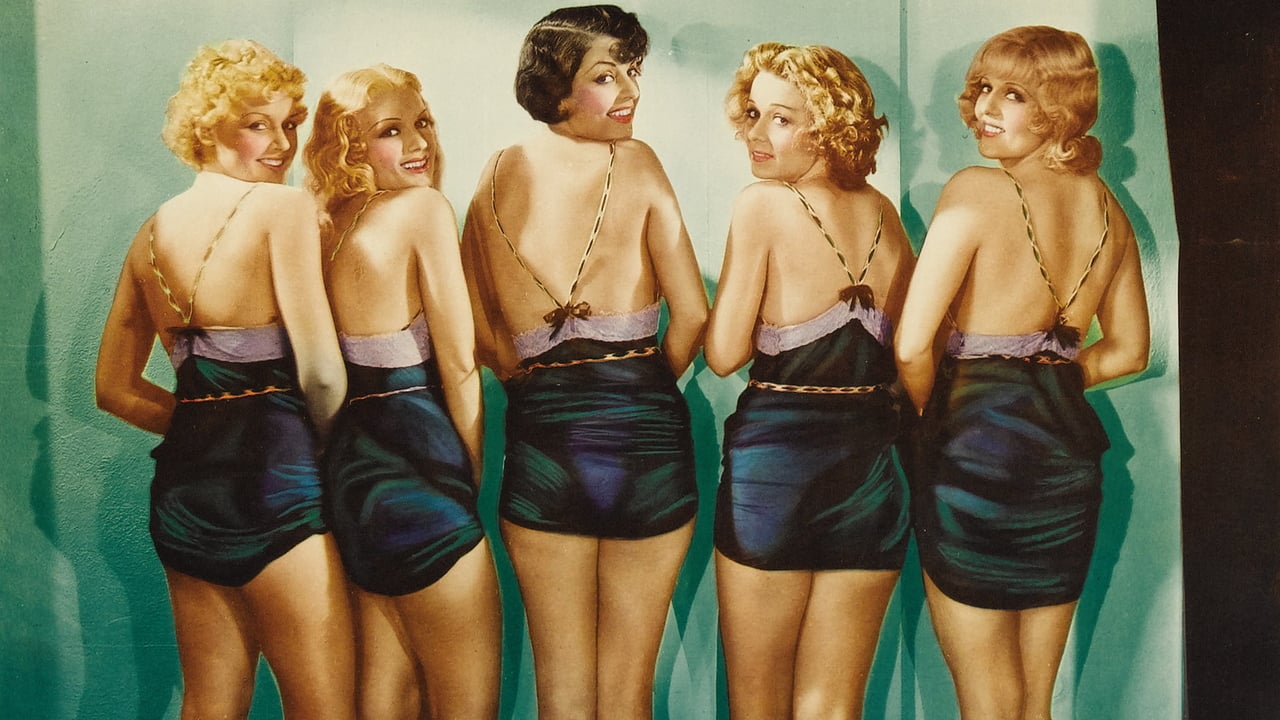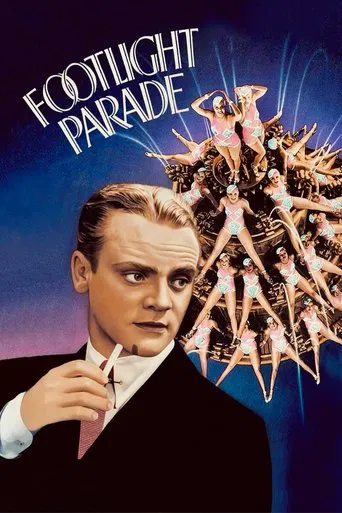

Truly Dreadful Film
... View MoreTerrible acting, screenplay and direction.
... View MoreOne of the best films i have seen
... View MoreIt was OK. I don't see why everyone loves it so much. It wasn't very smart or deep or well-directed.
... View MoreGreat showstoppers. Jimmy hoofing it up a storm, nine years before his boffo "Yankee Doodle Dandy". Ruby Keeler always excellent; superb. Joan Blondell -- spoiler -- gets Jimmy in the end, after she kicks his cheap trashy gold-digger, literally, to the curb, lol. Hugh Herbert with the famous hand-twirling -- always a delight. Jimmy's friend Frank McHugh terribly whiny as the dance director, and his wearing that huge cat's tail is totally hilarious. Cat number just divine, so is waterfall number. Honeymoon number full of pre-code innuendoes, but of course there is the justice of the peace just off the lobby. Berkeley always excellent, plus he is one of the cast. Look for him. 12/10
... View More'Tough guy' James Cagney finally got a chance to dust off his vaudeville-honed stage dancing skills, along with a central role as the harried ex-producer of Broadway shows, trying to start a new career as the producer of 'prologues': short live stage performances done just before the film is shown, designed to increase faltering movie attendance during "The Depression". As discussed as the web site entitled "Matinee at the Bijou: movie prologues", although I was born too late to experience them, such performances were a common reality during "The Depression", when many movie theaters were converted stage theaters, or were newly built, including a stage area in front of the film screen. Cagney's character is modeled after the Mike and Fanny Wolff team, who began mass producing prologues, created at their Hollywood studio, then sent out to various theaters near and far, at a cheaper price and with generally better(but cheap) talent than in house-produced prologues. This institution was eventually rendered uneconomical when movie studios changed the arrangement of this film rentals to a percentage of proceeds and began adding more film shorts to film packages, and when movie attendance became great enough without the added attraction of a prologue. Of course, most of these mass-produced prologues were relatively simple shows, hardly resembling the more complex Berkeley-choreographed film productions, and were mostly sold to the smaller theaters, which couldn't afford an in-house prologue troop.If you like Cagney's typical hyperactive, fast-talking, domineering , screen persona, you won't be disappointed here. Since this is the 'dirty '30s', this hard- working, on the level, ex-producer of lavish Broadway shows, played by Cagney, is the victim of a variety of parasites, traitors and incompetents, along with a few honest competent associates. There's his unfaithful, gold-digging wife, who walks out when his income slows to a trickle. There's Vivian, a tall, gold-digging, phony sophisticate blond friend of Cagney's secretary(played by Joan Blondell), who puts the squeeze on the new Cagney to become his new wife, while stabbing him the back, by informing his chief competition of his new show ideas, which they can't think of. Things get really crazy just before the 3 big musical productions, which consume the last half hour. First Cagney's supposed ex-wife shows up, announcing that she didn't get a divorce, demanding a $25,000. bribe to hush up his 'affair' with Vivian. Then, Joan somehow discovers that Cagney's business associates, who handle the finances, have been underreporting earnings from his prologues. Thus, she demands $25,000. for keeping quite, which she gives to Cagney, so he can continue his business. Soon after, Vivian is discovered in a clinch with the film censor, thus ending her affair with Cagney, and opening the way for a happy ending with a Cagney-Joan romance, Cagney having been blind to her virtues until now. ...As a side note, Frank McHugh plays Cagney's whining, overwhelmed, dance director, forcing Cagney to often take over the dance direction himself. These backstage scenes can get a little repetitious. Among Cagney's other friends, we have Ruby Keeler, as his sometimes secondary secretary and sometimes star dancer, with whom he dances a bit in the final production: "Shanghai Lil". Dick Powell, who functions as Ruby's romantic admirer, at least superficially brushed off until just before the big productions, when they are an important romantic pair in 2 of them.The dance productions are formulated as in the previous "Gold Diggers of 1933", there being 4: one of them a 'minor' production, early or midway in the film, instead of just the 2 or 3 big productions late in the film, as in the other films in this series. Thus, the relatively short and simple "Setting on a Backyard Fence", with chorus girls dressed in full feline costumes, prancing around, is functionally equivalent to the rather short production 'We're in the Money", in the beginning of "G.D. of '33". "Honeymoon Hotel" clearly is functionally equivalent to "Pettin' in the Park", of "G.D. of '33": sexually -oriented numbers that the censors would have the most objections about. It' a bouncy romantic-themed number, light on Berkeley's signature features. Clearly, it's implied that this hotel functioned more like the 'love hotels' of current Japan and Taiwan, rather than a true honeymoon hotel. The very impressive "By a Waterfall" production clearly is functionally equivalent to "The Shadow Waltz" number in "G.D. of '33, which featured girls with neon-lit violins. The "Shanghai Lil" production is the functional equivalent of the last production in "G.D. of '33": "My Forgotten Man". Both initially dramatize seamy subjects: extreme poverty in the one case, and an oriental bar and prostitutes, followed by many marching military men in the latter part. The team of Harry Warren and Al Dubin, who composed all the songs in some of this film series, and only the songs for the major productions in others, only composed "Honeymoon Hotel" and "Shanghai Lil" in this film. Sammy Fain and Irving Kahal composed the other novel songs, including "By a Waterfall". I think I would have put this latter production last, as it is, by far, the most impressive and unique of the productions, thus would be best remembered by leaving audiences. It provides a primer for most of Esther Williams' film career, specializing in water ballets, one of which was choreographed by Berkeley...Also, Cagney's rather brief dancing scenes provided the main visual evidence for his suitability to play George M. Cohen, in Cagney's most famous film role, nearly a decade later, in "Yankee Doodle Dandy", as well as in the subsequent "The Seven Little Foys"
... View MoreI am thankful for these so-called 'backstage musicals'; beyond their superficial charms, they have deepened the ways we imagine. Without knowing it they have provided us with some of the best essays about the endeavor to express, to make visible, the unfathomable contours of the heart.Once more we have a film about a filmmaker fighting to stage a vision, here a preshow as opening act for the first talkies. He's a grunt, always storming in and out of rooms, yelling directions, now and then pausing to show the steps to the troupe or scream at a phone; but always fretting about new ideas to stage. He's played by James Cagney, whom we know best from tough-as-nails gangster roles. It's very apt casting. Cagney had many expressive talents, and a violent energy with the intuitive power to carry these into a performance.But none of the ideas he comes up for the show seem like they've been very well thought out, they're all unfinished premises rushed with one foot out the door, so it's all a mystery how this strong-willed hack can give coherent shape to creative chaos. What kind of show he'll be able to put together. Money is staked on him, fortunes.He's surrounded by three women, one for each number he's called to improvise. One is an ex-wife out for leeching money, another is his loyal secretary secretly in love. All three are fighting to seduce or be seduced, money is at stake again, and the art made with them.It's all very enjoyable thus far, the rapid-fire banter and atmosphere of festive uproar. But it's not that it truly soars until we actually get to see on the stage how the various tribulations, that from our end so far seemed random and meaningless, were in fact shaping the vision that we get to see.We drive back and forth around town to see these; the first number is about newly weds in the 'Honeymoon Hotel' with marriage slyly perverted as illicit sex that ends with bedroom eyes and mock happiness which we know will not last, and didn't for him, the other is a scene from everyday life on the street transformed on stage into the most gaudy spectacle with wood nymphs frolicking beneath cascading waters.The third is the most stunning, because it substitutes for the internal processes that yield one happy end within another, both on the same stage. We knew our man was the author of these visions, the dreamer as it were, but was content so far to pull the strings from behind. Here an accident of fate forces him to get up on that stage and act out the part he was intuitively drawn to create: the number is about this man seeking out the woman of his dreams in a sort of smoky, semi-conscious stupor, and again the unforeseen circumstances - in this case, war - that keep love from them. Eventually he tricks both fates and us, the camera, to fulfill the dream.So the happy end meant to take place in reality is pure Hollywood fiction, while the pure Hollywood fiction of the song and dance number reveals from machinations inside the soul a true purpose outside.It is excellent stuff about the makings of images choreographed from the heart. Their power to articulate is this; art that reflects, salvages purpose from a life that appears incoherent, yet also reveals capricious fates of our own making that we have set in motion by simply living our part. Clearly this grunt could not have staged what he did, even with expert craft, if life around him had not seduced inspiration out of him.
... View MoreDick Powell switched from musicals to drama; Jimmy Cagney wanted to go the other way around. They co-star in the best musical yet, "Footlight Parade."Let's get away from the brilliant observation that the stage would have to cover three blocks to put on the Busby Berkeley extravaganzas.He is at his best, and that is saying something, in this movie made when I was 5-years-old. Talk about spectacular. Check the three outstanding numbers at film's end. Esther Williams water to-dos may have the advantage of Technicolor, but, fun as they are, they couldn't hold a candle, not even a small one, to the watery choreography in what seems like a rather small swimming pool. Then, you have the red-white-blue spectacle, and the other number featuring Powell and ultra-cute Ruby Keeler, the absolutely great "Shanghai Lil" piece, and one more brilliant number. They climax the film, coming one after another.In-between there is the requisite backstage stuff, enhanced in this case by the best character actors of the era, and Joan Blondell in her first wisecracking role.Busby Berkeley puts his best foot forward - well, legs - in this absolutely, still to this day unbelievable - musical, typical of the Warner Brothers products of this day, all of them 100% percent entertaining. It's 200% in the case of "Footlight Parade."Like the other reviewers I read, I unequivocally recommend this movie. Still, in 2011, it is unequaled. By the way, the accompanying features are great - shows unto themselves.My knees are hurting. I've bent them begging one and all to see "Footlight Serendade" at least five times -- for starters.
... View More